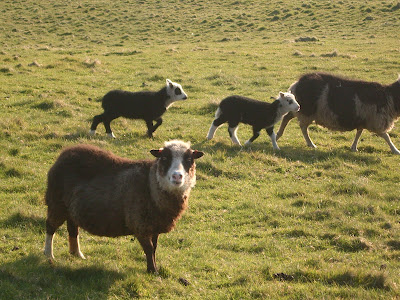A matter of blocking...
I started knitting when I was about 9 years old and until recently I never made the effort to block my work. Although I'm not old enough to retire, I am old enough to get solicitations to join AARP...so that's a fairly long time. Blocking has always seemed like too much of a bother...
As a former professional weaver, it never would have occurred to me not to finish my weaving once it came off of the loom. I can't remember how many times I've told students that your work it not done until it's been washed, fulled and ironed. Somehow this just never seemed to apply to my knitting hobby...until a few years ago when I was listening to
Elizabeth Johnston giving essentially the same comments regarding knitting as I used to give regarding weaving. The light bulb finally went off!
 |
| Elizabeth's hat and lace shawls in the background |
During the class on knitting Fair Isle in 2010 held at the Nordic Heritage Museum in Ballard, WA,
Elizabeth showed us some techniques for blocking a hat she had knit. She used a plastic colander to get the shape of a head and later, after it had dried she steamed the hat edge back into shape so that it fit more snugly onto the head. It turns out that blocking was all about getting your knitting to look good and do what you wanted it to do. Another light bulb went off...
Several years ago, I knit a wool sweater for my husband. He had tried it on several times and kept asking me to knit it a bit longer each time. I was getting close to the end of this project and was getting anxious to be done with the whole thing, so I decided that it was indeed long enough - for me. Unfortunately he never wore it much after that because...you guessed...it was too short for him.
After
Elizabeth's blocking demonstration I went home and dug out his sweater from the back of the closet. Next I found my wooly board or 'jumper board'.
 |
| 'Jumper boards' in Shetland - Photo #P05489 taken in 1952 from the Shetland Museum Photo Archives |
I washed up his sweater, spun the water out and put it on the wooly board. To stretch the sweater lengthwise, I then laced a long piece of yarn through both sides of the bottom of the sweater and then around the bottom of the board. I did this several times to create an even tension along the bottom of the sweater. At this point I started to tighten my yarn and stretch down the bottom of the sweater. I managed to stretch the sweater almost four inches longer than it had been originally.
The sweater sat in the corner for a few days drying. As I impatiently unlaced my piece of yarn to see if this 'experiment' had actually worked, I was thrilled to find out that my husband's 'too short' sweater was now just right! And best of all it stayed this way, at least until the next time I washed it. He's even taken to wearing it again! Now I can't imagine knitting anything without blocking it after it's finished and washed. I wonder what took me so long...













